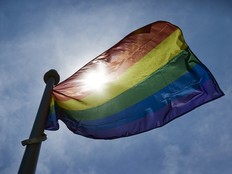Decades after her death, Princess Diana is still larger than life

Article content
Reviews and recommendations are unbiased and products are independently selected. Postmedia may earn an affiliate commission from purchases made through links on this page.
Does Diana, Princess of Wales, still matter? So much else has happened since her shocking car-crash death in Paris in 1997 – 9/11, the Iraq War, Barack Obama, Brexit, the first Trump presidency, the pandemic, the start of Trump’s second term.
Consider this: Kensington Palace in London has an exhibition called “Dress Codes” featuring gowns worn by some rather significant women, including groundbreaking designer Dame Vivienne Westwood, Princess Margaret, Queen Victoria and Queen Elizabeth II. Not a bad lineup. But out in the hallway, by the entrance, bigger than life and positioned to bring in the crowds, is a glamorous photograph of a single figure, the exhibition’s main lure: Diana, Princess of Wales.
As biographer Edward White ably demonstrates in “Dianaworld: An Obsession,” the once-bashful beauty who married her frog of a prince defies death’s diminution constantly. While he presents few new facts about Diana’s life – inevitably, given how exhaustively she was covered both before and after death – White takes advantage of a quarter-century’s distance to present the cultural postmortem she deserves. His astute evaluation of what the princess was and continues to be, to the people who knew her and the millions who didn’t, makes a convincing case that her populist presence in the 1990s presaged the politics of the 21st century.
Lady Diana Spencer first walked onto the world stage in 1981 as an anachronism, a throwback, a teenager who’d attended finishing school not high school, a blue blood in the age of punk, a young bride at a time when young women having sex and postponing marriage was the norm. But she rapidly became a change agent, a breath of fresh air among the fusty royals. Not for her the formal walkabouts; Diana plunged into crowds to meet fans up close – to chat, to share confidences and, most significantly, to touch and hug. She made big news shaking hands with an AIDS patient. As years passed, she intimated she possessed the healing touch, the same that royals in ancient times were said to have. Modern princess, mythological powers – such was the contradictory nature of Diana, an aristocrat who began to fancy herself the people’s champion. White aptly calls the princess a “cut-and-shut” figure, referencing the way two damaged cars can be welded into a single, imperfect vehicle.
Behind palace doors, after her marriage crumbled, she took a lover and secretly puppet-mastered her own bombshell 1992 biography “Diana: Her True Story.” Her capacity for risk-taking was enormous, White notes, and it “exacerbated almost every difficulty she encountered as a member of the royal family.” But this was part and parcel of her grandiosity. Rejected by a cruel husband, she was summoned, according to the book, to a higher purpose. She once said to a startled Peter Nott, bishop of Norwich: “I understand people’s pain, people’s suffering, more than you will ever know.”
White, previously the author of “The Twelve Lives of Alfred Hitchcock,” employs an overly academic style on occasion, perhaps aiming to resist the hyperbole surrounding Diana. He also devotes considerable space to the feelings of ordinary people, relying on oral histories in the British Library, personal testimonies included in the Mass Observation project at the University of Sussex and private diaries. Most never met Diana, yet “consider her a vital presence in their lives,” he writes. Is it churlish to describe those sections as the least interesting? Far more compelling is White’s analysis of Diana’s impact on the monarchy, British politics and wider society.
After her separation from Prince Charles, she formed a quasi-alliance with Tony Blair and his New Labour movement. For a time, they appeared to sing from the same hymnbook. The princess believed in a reformed, consoling monarchy; Blair promised a post-Thatcher Britain “in which ambition for oneself and compassion for others can live easily together.” Diana hoped that once Blair became prime minister, he’d appoint her as a sort of roving brand ambassador for Britain – a humanitarian on the hoof, who also waved the flag. “Nobody, including Diana, really knew what such a position might entail,” White notes.
It never came to pass, as Blair disapproved of Diana’s willingness to be drawn into the orbit of Mohamed al-Fayed, the Harrods owner, who had been implicated in a scheme to bribe members of Parliament. Blair advised her to stay away from al-Fayed, but, Diana, willful as ever, instead distanced herself from the prime minister and started dating Fayed’s son. Dodi Fayed died in the car crash that also killed her.
What followed in Britain was unprecedented: national mourning was so emotional, so unbridled, that one observer, future prime minister Boris Johnson, called it “a Latin American carnival of grief.” In the run-up to the funeral, Queen Elizabeth II was hectored by the media into flouting protocol and flying the Union Jack over Buckingham Palace at half-staff, and making a public attestation to her sorrow in a televised speech.
Diana, Blair once said, invented a “new way to be British.” White counters, “It might be more accurate to say that through Diana, the British invented a new way of fantasizing about themselves.”
RECOMMENDED VIDEO
Whatever transmogrification took place, the royal family got the memo. They have abandoned the stiff upper lip; nowadays they speak openly about their emotions and eschew pompous patronages to concentrate on social ills. Prince William aims to end homelessness in Britain – his mother having taken him at age 11 to visit a London shelter to meet those with no place to live. He and his wife, Catherine, have spearheaded a mental health initiative called Heads Together. Notably, William chose a spouse radically different from his mother: introverted, measured and cautious rather than impulsive and reckless. But thanks to Diana’s rejection of royal conventions, her son had greater freedom to pick someone from outside the ruling class. (Famously, Catherine’s mother is a former flight attendant, her father a former flight dispatcher for British Airways.)
Diana’s life as a divorcée in the 1990s and the response to her death “did inject into the mainstream of British life a strain of populism that had usually existed only on the fringes,” White writes. While he resists linking Diana directly to Brexit, he accurately points out how the political climate in Britain has never been the same. Authority is met with less deference. Institutions are more open to outsiders. Politicians weep on camera and urge the public to show troubled youths more love. And leaders can be chastised for appearing to lack feeling. In a bizarre episode earlier this month, Kemi Badenoch, head of the Conservative Party, was questioned closely on a BBC News show as to why she hadn’t yet watched the widely discussed Netflix drama “Adolescence” about a West Yorkshire boy who murders his classmate. Badenoch countered that she prefers to devote time to meeting real people in trouble rather than watching television dramas. It’s hard to imagine this exchange happening in pre-Diana Britain.
Of course, interest in the princess has always spanned the globe, and a new generation is meeting the rebel royal through the numerous television, film and theatrical productions about her. The obsession, in White’s view, shows no sign of fading away.
– – –
Clare McHugh is the author of the novel “The Romanov Brides.”
– – –
Dianaworld
An Obsession
By Edward White
W.W. Norton. 416 pp. $31.99











Postmedia is committed to maintaining a lively but civil forum for discussion. Please keep comments relevant and respectful. Comments may take up to an hour to appear on the site. You will receive an email if there is a reply to your comment, an update to a thread you follow or if a user you follow comments. Visit our Community Guidelines for more information.